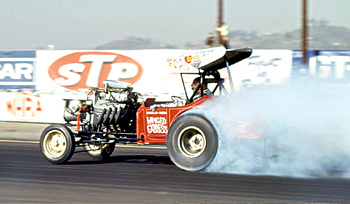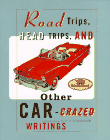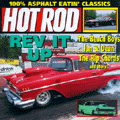 |
|||||
|
|
 |
|
|||
|
|
|||||
|
With that out of the way, I'll deal with why I see 1966 as the beginning of a golden age for Fuel Altereds. From roughly 1958, the year AHRA set the blown fuel dragsters apart from the gas versions, through the early 1960s Top Fuel and Top Gas were the star cars. Why not? They were quicker and faster. By 1966, the Funny Cars began edging their way to the top of the list and what this meant was "almost" permanent second-class citizenship for the altered coupes and roadsters. For example, at a July 30 Irwindale show, a big 16-car Top Fuel show was bannered in an ad, featuring all the best Southern California cars and a $1,000 winner's purse. Listed in smaller letters below were the other players, an eight-car Competition show that paid $225 to win as well as a similar structure for the Fuel Altereds. Sharing in the pie were a four-car Junior Fuel field and a similarly numbered A/Gas Supercharged group ... and that's as good as it got for the Fuel Altereds in 1966. They, like A/GS, Comp, Junior Fuel and Gas, and four or five brackets were the preliminaries before the main event. The average field size for Fuel Altered was four cars. In 1966, a healthy 30 Fuel Altered shows were hosted in Southern California, and of these, 26 of them were four-car afterthoughts. The remaining four were pumped up mainly because they were a part of a track's big annual event. The Irwindale Grand Prix, for example, had an eight-car Fuel Altered show. However, the very nature of the Fuel Altered led to them getting star billing in the following year. Despite their performance status compared to Top Fuel and Top Gas, they produced every bit the excitement and more. The wheelstands, the fireballs, the totally-sideways runs, and legitimately, great e.ts and mphs led to their getting to head the bill in 1967. WILD WILLIE BORSCH Borsch was a fearsome-looking presence. Just under six feet tall, the Gardena, Calif., driver looked at first glance like an axe murderer. Bald on top and literally covered with hair, full beard and all, Borsch's had the kind of countenance you don't forget. Despite that, he was a soft-spoken soul and, according to his friends, was narcoleptic. That means he fell asleep a lot, like in the staging lanes. Certainly not on the starting line, though. He was totally fearless and, if nothing else, won more races driving with one hand than any drag racer who ever lived. Borsch's roadster had a bench seat until the spring of 1967 and when he stomped on the throttle the 1,000-plus horsepower would send him sliding to the driver's side of the car. The cure? Just slide your left arm over to the pipe and hang on. As Borsch once told me, "It's really no big deal, most people drive their passenger cars with one hand."
Borsch won seven races in 1966, including the Fuel Altered title at the AHRA Nationals at Lions, and carded a best elapsed time of 8.65 at 181.80 mph. |
|
||||
|
|
|||||

Copyright 2000, Drag Racing Online and Racing Net Source |
|||||
 The car that made "Wild Willie" Borsch famous was the Harrell-Borsch-Muse
'23-T Ford, Chrysler-powered roadster. This is the one Borsch "one-handed"
routinely on 7-second, 200-mph runs and the one that sported the big
stabilizer wing directly over the driver's head. The version that he
ran to early 1967 was built in 1961 by Borsch, Phil Johnson (who welded
the chassis), Nick and Jim Harrell and Don Reynolds. The 1,510-pound
AA/Fuel Altered was 95 inches long and sported a 358-cid Chrysler Windsor
engine which wasn't replaced (with a 392) until the decade of the 70s.
The Howard-cammed fuel burner made over 1,000 horsepower in the middle
1960s and featured a Cal-Auto fiberglass body, a 3.56 rear end, 10.00
M&H rear slicks, Weiand pump drive, Delta blower drive, Donovan valves,
rocker arms and intake manifold, a GMC 6-71 blower, Hilborn injectors,
a Schiefer clutch, ForgedTrue pistons, a Vertex mag, and 1954 Chrysler
New Yorker heads.
The car that made "Wild Willie" Borsch famous was the Harrell-Borsch-Muse
'23-T Ford, Chrysler-powered roadster. This is the one Borsch "one-handed"
routinely on 7-second, 200-mph runs and the one that sported the big
stabilizer wing directly over the driver's head. The version that he
ran to early 1967 was built in 1961 by Borsch, Phil Johnson (who welded
the chassis), Nick and Jim Harrell and Don Reynolds. The 1,510-pound
AA/Fuel Altered was 95 inches long and sported a 358-cid Chrysler Windsor
engine which wasn't replaced (with a 392) until the decade of the 70s.
The Howard-cammed fuel burner made over 1,000 horsepower in the middle
1960s and featured a Cal-Auto fiberglass body, a 3.56 rear end, 10.00
M&H rear slicks, Weiand pump drive, Delta blower drive, Donovan valves,
rocker arms and intake manifold, a GMC 6-71 blower, Hilborn injectors,
a Schiefer clutch, ForgedTrue pistons, a Vertex mag, and 1954 Chrysler
New Yorker heads.




